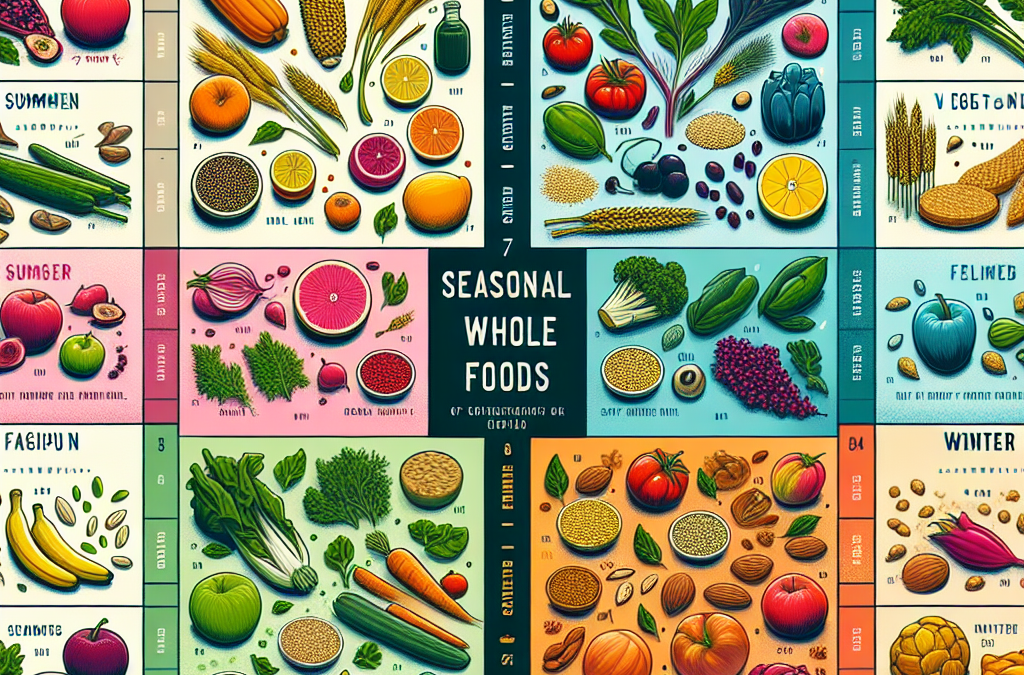Understanding the Benefits of Seasonal Eating
Healthier Choices
Let me tell you, one of the biggest perks of choosing seasonal whole foods is how they can seriously boost your health. When fruits and vegetables are in season, they tend to be fresher, which means they’re packed with nutrients. For instance, think about tomatoes in summer. Those bad boys are bursting with flavor and far more nutrient-rich than their off-season counterparts. It’s like nature’s way of reminding us to grab what’s ripe and ready!
Plus, seasonal produce is often grown closer to home which means it’s likely to have fewer preservatives and chemicals. Eating locally doesn’t just enhance your meals; it’s a win for your health! I personally feel that excitement when I grab fresh veggies from the farm stand. You can taste the difference, no doubt about it!
And let’s not forget how seasonal foods can help improve your overall well-being. There’s something magical about enjoying food at its peak flavor and freshness that brightens your mood. The act of shopping for what’s in season can also be a more thrilling adventure than just picking the same old stuff any time of year.
Learning About Local Growing Seasons
Researching Your Area
Tying into the local scene is often underestimated when it comes to seasonal eating. Trust me, learning about local growing seasons has greatly enriched my understanding of food. Every region has its unique timeline for when produce comes into season, so doing a little homework can go a long way. You can easily find local farm guides or resources online that lay this out clearly.
Not only that, but visiting farmers’ markets is a fantastic way to get to know your local produce. When I stroll through a market, I love chatting with the farmers about what’s coming in season. Not only do I learn a bunch, but I also build a connection with the food I eat, which is incredibly rewarding.
So if you’re wondering where to start, just hit up a local market or a community-supported agriculture (CSA) program. Knowing what’s available when definitely makes seasonal cooking more fulfilling and fun!
Identifying Seasonal Foods
Using a Seasonal Produce Chart
Now, this might sound a bit geeky, but using a seasonal produce chart is a total game changer. You can find tons of them online; they’re like cheat sheets for what’s in season. I started with a simple printed version on my fridge, and it’s been invaluable! I use it to plan my shopping list and meals around what’s currently at its best.
These charts not only highlight what fruits and vegetables are in season but also give you an idea of when to expect certain items. This web of knowledge feeds my passion for cooking, and it’s honestly a thrill to create a dish that celebrates what’s fresh right now!
And if you’re feeling extra adventurous, you could experiment with lesser-known seasonal produce that you might not have considered before. Nothing like trying something new and finding it becomes a favorite!
Building Recipes Around Seasonal Ingredients
Freezing and Preserving
Alright, let’s talk practicality! When we’re knee-deep into a bountiful harvest season, I’ve found that freezing and preserving becomes my best friend. This way, I can savor the flavors of summer during the chillier months, and trust me, there’s a certain nostalgia that comes from tasting last summer’s tomatoes in a cozy winter soup.
Get an Amazing Discount on the Best Certified Organic Whole Food Supplement!
I’ve gotten into the fun of preserving seasonal foods, whether it’s pickling cucumbers or making jam with fresh berries. It’s a bit of a labor of love, but man, is it worth it! Plus, it’ll give you that burst of summer sweetness even when it’s cold outside.
When I whip up recipes around seasonal ingredients, it also sparks creativity in my kitchen. You can’t just stick to the usual; you’ve gotta find new ways to utilize those ingredients. And who doesn’t love sharing those creations with friends and family? It turns into an open invitation to explore flavors together!
Shopping Smart for Seasonal Whole Foods
Choosing Quality Over Quantity
Listen, when you’re out shopping, sometimes it’s easy to get caught up in wanting to buy everything. But let me tell you, focusing on quality really makes a difference. Each piece of produce should tell a story of freshness, and buying in-season whole foods is the best way to make sure you’re getting that. I always look for vibrant colors and firm textures when I shop.
Another hack I’ve learned is to embrace the imperfections of seasonal foods. Sometimes you’ll find weird shapes or various blemishes, but that’s part of the charm of working with nature! More often than not, those oddballs taste phenomenal. It’s all about the flavor, baby!
And be sure to ask questions! Most farmers love sharing about their practices and the best ways to use what they grow. That connection not only enhances my shopping experience but also supports my local community, which is super important to me.
FAQ
1. Why is it important to eat seasonal whole foods?
Eating seasonal whole foods is important because they are fresher, tastier, and often more nutritious. When produce is in season, it’s picked at the peak of its ripeness, thus retaining more flavors and nutrients.
2. How can I find out what produce is in season?
You can find out what produce is in season by checking local seasonal produce charts available online or visiting your local farmers’ market and asking the vendors directly.
3. Can I buy seasonal foods at supermarkets?
Yes, many supermarkets stock seasonal produce, but it’s often best to check your local farmers’ markets for the freshest, local options. They usually have a wider variety of seasonal goodies.
4. What are some tips for preserving seasonal foods?
Some great tips for preserving seasonal foods include freezing, canning, and pickling. Make sure the produce is fresh before you preserve it, and follow proper preservation techniques for the best results.
5. How can I integrate seasonal foods into my meal planning?
You can integrate seasonal foods into your meal planning by planning your meals around what’s in season. Create a shopping list based on seasonal produce charts and let that guide your recipes!




